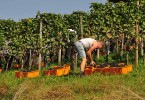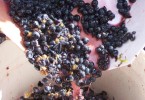Barrel fermentation and its preparation
The barrel is a wooden bowl that holds the wine. Wood must be of high quality and its manufacture must follow strict rules. The wine in the barrels should be enriched with advantages and not flaws. The most used wood is oak. After being harvested in the forests, it is left to dry and season even for years before processing it. Wooden strips (slats) are put together thanks to metal circles placed in such a way to give the barrel a cylindrical shape. Before giving it a definitive shape, however, the slats are bent under the action of the heat. In the next step roasting is carried out.
This process is crucial to define the quality of the aromas that the wine will express after being in the barrel. Toasted, spices, honey, tobacco, chocolate, hazelnut and many other scents derive from the effect of heat on the wood.
The next step is to fill the barrel of water to check the resistance to the fluid.
Barrel fermentation, a privilege only for precious red wines
Through the process of fermentation the sugar of the must is transformed into alcohol, carbon dioxide and energy. In recent years, steel, cement or glass fiber containers have been used to prevent hygiene problems. The fermentation in barrels, however, has the great advantage of enriching wine with a rich and complex bouquet. After a soft pressing, the must is left to macerate with peels and stalks for a period between 7 and 20 days, to encourage the release of anthocyanins and polyphenols.
The former are responsible for red color, while the latter are antioxidant substances. Rowing is the next step with which to separate the must from the pomace. In this moment the wine is placed into barrels. The first fermentation is called tumultuous, because the must boils for the great quantity of carbon dioxide that it develops. The fermentation in barrels, however, is slow. The must will continue to develop gas, but lower. In fact, barrels are equipped with gas discharge siphons. In this step, acidity will decrease due to the precipitations of tartaric acid. Many substances, still in solution, will deposit and the wine will become clear. The wine, therefore, will mature and it will enriched with various and complex notes.

Barrique, small barrels
Barrique is a barrel of 225 l oak. In recent years, its use has been widely spread and as there is always a younger audience approaching this sector, this technique was also used for white wines. The optimal consumption for the latter goes from the spring of the year following the harvest to 2-3 years, depending on the starting grape variety. The characteristic of these wines should be a strong acidity that makes them pleasing to taste. With the passage in barriques, you want to dampen this feature and at the same time give smells of vanilla and toast. The most suitable vines are Chardonnay, Sauvignon, Muller Thurgau, Trebbiano and others with the same structure.
Barrel and barrique
In the larger barrel, the wine-wood ratio is in favor of the first. The amount of notes and Gallic tannins is lower than in the use of barrique. The wine will be less tannic and round. In fact, in the barrique, the taste of wood tends to cover the aromas contained in the wine, with the result that wines from different vines have similar taste. Barriques have a high cost and a fairly short life expectancy. A useful suggestion is to re-use them by putting red wine in a barrique where the white one was previously held. The opposite is impossible. However, in recent years, there has often been a dispute between traditionalists and innovators.
Source: wikimedia.org







